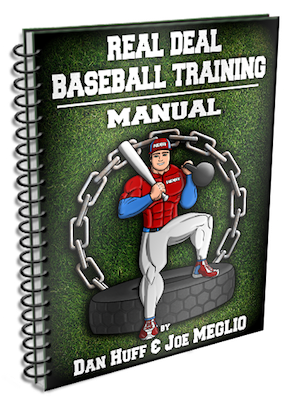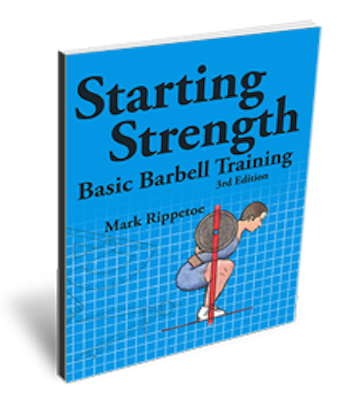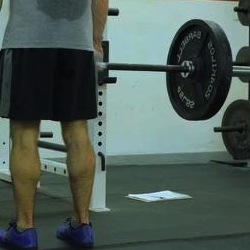The off-season is the best time of year for baseball players to focus on their strength and conditioning. Before beginning any program, you should make sure you define your goals and have a clear focus as to what you want to accomplish. Some general goals to keep in mind for the off-season should be to recover from the previous season, rehabilitate existing/nagging injuries, and develop a strength and conditioning foundation for the following training year.
As discussed before, the training year can be broken down into off-season, pre-season, and in-season segments. Within each season, you can break down the different months into 4 week phases.


For the purposes of this post, we will create an example baseball strength program for Phase 1 of the off-season. For this phase, our goals will be, but are not limited to:
- Begin recovery work from the prior season.
- If needed, rehabilitate any existing injuries.
- Start a strength program that builds general strength and allows us to create a foundation upon which to build further in later phases of the training year.
- Give the arm a break from throwing. Do not pick up a baseball.
Now, there is no official “start date” to the off-season. Each athlete will begin his individual program at some point after the previous season ends. Many coaches will advise to take off 2-4 weeks from everything, but you will have to make that call for yourself. If you are otherwise healthy and not feeling overly fatigued, you should start your off-season strength program sooner than later.
Off-Season Baseball Strength Program – Overview
Each training day will include the following segments, and each segment will be done in the order listed:
- Foam Roll/Soft Tissue Work
- Pre-hab
- Dynamic Warm-up
- Strength Work
- Conditioning
- Post-Training Session Static Stretching
- Foam Roll
For the purposes of this article, a 3-day per week program will be considered. A baseball off-season strength program can be 2-5 days depending on the individual and how the program itself is structured. Before we dive right into the exercises and movements, let’s take a moment to discuss soft tissue work, pre-hab, and a dynamic warm-up. These aspects of a baseball strength program are often overlooked or very poorly executed. So, let’s take a quick look at these first three training methods.
Foam Roll/Soft Tissue Work
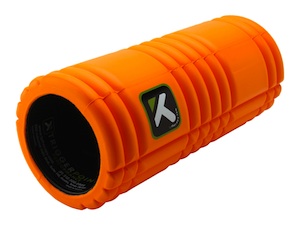 Soft tissue work is often the missing piece in many athletes’ training programs. Ideally, every athlete would have a manual therapist or massage therapist that they could see on a regular basis to help with sore muscles, injuries, and overall recovery. Unfortunately, these services often cost more than most young athletes and their parents can afford. So, we look toward a more economical approach – the foam roller. The technique is simple – apply pressure to sore muscles by placing your bodyweight through the foam roller. Prior to a training session, foam rolling can help decrease muscle “tightness” and contribute to a better warm-up. Foam rolling after a training session can help muscles begin recovery from exercise. So in the example program below, you will see foam rolling listed at the beginning and end of each training day. If you do not have a foam roller, we strongly suggest you pick one up and make it a part of your training routine. You can pick one up on Amazon for a very reasonable price. We like this one.
Soft tissue work is often the missing piece in many athletes’ training programs. Ideally, every athlete would have a manual therapist or massage therapist that they could see on a regular basis to help with sore muscles, injuries, and overall recovery. Unfortunately, these services often cost more than most young athletes and their parents can afford. So, we look toward a more economical approach – the foam roller. The technique is simple – apply pressure to sore muscles by placing your bodyweight through the foam roller. Prior to a training session, foam rolling can help decrease muscle “tightness” and contribute to a better warm-up. Foam rolling after a training session can help muscles begin recovery from exercise. So in the example program below, you will see foam rolling listed at the beginning and end of each training day. If you do not have a foam roller, we strongly suggest you pick one up and make it a part of your training routine. You can pick one up on Amazon for a very reasonable price. We like this one.
Pre-hab
Many coaches and young athletes have never heard the term “pre-hab.” If rehab is what you do after an injury, pre-hab is what you do to protect against injury. Now, injury prevention is never 100%. But, by incorporating pre-hab exercises in your training program, you can work on ironing out muscle imbalances caused by repetitive movements and hopefully decrease the chance of injury. For baseball players, pre-hab work is most often focused on the shoulders, hips, thoracic spine, and core. As a ballplayer, you want stability through your shoulders and core, while having stability and mobility through your hips and thoracic spine. Pre-hab exercises work on these areas. When designing a strength program, pre-hab movements can be inserted almost anywhere within a given workout. However, placing them near the beginning of a training session can also serve to activate, or “wake up,” those areas of the body and prime them for the upcoming training session.
Dynamic Warm-up
Let’s cut straight to the point regarding a good warm-up. Static stretching should be saved for post-activity and dynamic stretching should be done prior to activity. This not only applies to training sessions, but practices and games as well. Dynamic stretching movements stretch a muscle for 4-6 seconds and follow that stretch by a contraction (or shortening) of that muscle. Static stretching involves a slow, controlled movement that has the athlete hold a stretch for an extended time of 30-60 seconds. Looking at it another way, the goal of static stretching is to relax your muscles while the goal of dynamic stretching is to wake them up. You definitely want active muscles when training or playing. Using a dynamic warm-up will also increase your body temperature, heart rate, and blood flow to your muscles. Your long-term mobility and flexibility will improve too.
Now that we have covered these areas of a training program, let’s take a look at this sample 3-day baseball training program.
Sample Off-Season Baseball Strength Program – Phase 1
When starting your off-season program, be sure to train on non-consecutive days. You’ll want to give your body 36-48 hours to recover between training sessions. While the examples below will include conditioning on the same days as lifting, you could perform your baseball conditioning on non-lifting days. For example, if you strength train on Mon/Wed/Fri, you can perform you conditioning after your lifting session on those same days or on Tues/Thurs/Sat. If you decide to complete your lifting and conditioning on opposite days, be sure to have at least one day per week that is devoted completely to recovery. In this example, that would be Sunday. That means no strenuous activity. Either take the entire day off or focus just on soft tissue work and static stretching.
**We understand that you may not be familiar with many of the exercises listed below. A quick search will direct you to videos and explanations that can help you better understand the movements. However, just watching a video will not take the place of a qualified strength and conditioning coach who can demonstrate technique and properly correct form if there are any issues. When in doubt, do not perform the movement. Seek guidance and instruction. If any exercise causes pain, use common sense and do not do it.**
Day 1
Foam Roll
- Glutes – 1 x 60 seconds each side
- IT Band – 1 x 60 seconds each side
- Quads – 1 x 60 seconds each side
- Groin – 1 x 60 seconds each side
- Hip Flexor/TFL – 1 x 60 seconds each side
- Mid/Upper Back – 1 x 60 seconds each side
This is a good starting point for foam rolling. However, be sure to listen to your body. It will tell you if certain areas need more or less focus. You can always spend longer on one area if need be.
Pre-hab
Perform the following movements in a circuit by completing one set of each exercise and then return to the start and complete any movements with additional sets.
- Glute Bridge Hold – 2 x 20 seconds
- Lateral Band Walk – 1 x 10 steps each direction
- Quadruped Rotations – 2 x 6 each side
- I’s, Y’s, T’s, External Rotation with band – 2 x 10 each
- Plank – 1 x 45 seconds
Dynamic Warm-up
The following should take 10-12 minutes to complete. Set up two cones 10-15 yards. Start on one cone and move in the direction of the second. When you complete the required distance for a movement, jog back to the starting cone. Complete each movement deliberately. Do not just go through the motions.
- Reverse Lunge with Twist – 1 x 10 yards
- Inverted Hamstring Stretch – 1 x 10 yards
- World’s Greatest Stretch – 1 x 10 yards
- Inch Worms – 1 x 10 yards
- Straight Leg March – 1 x 10 yards
- High Knees – 1 x 10 yards
- Butt Kicks – 1 x 10 yards
- Lateral Shuffle – 1 x 10 yards each direction
Strength
Exercises listed below are paired in supersets. Training in supersets means that you will perform one set of the first listed exercise and then one set of the second listed exercise. Take 45-60 seconds of rest and then repeat for the second set of each. Continue this method until all sets in a given superset are completed. Then, move to the next two exercises that are paired together as a superset.
- Box Jump – 4 x 5
- Medicine Ball Rotational Throw – 4 x 5 each side
- Trap Bar Deadlift – 3 x 5
- DB Bench Press – 3 x 6
- DB Reverse Lunge – 3 x 6 each
- Inverted Row – 3 x 10
- Stability Ball Hamstring Curl – 2 x 12
- Scapular Wall Slide – 2 x 12
- Cable Pallof Press Hold – 2 x 10 seconds each side
- Prone Low Back – 2 x 10
Conditioning
Short Pick-ups – You’ll will need a partner and two baseballs. Have your partner start with both baseballs and setup roughly 5-7 yards apart. Start by moving laterally as your partner rolls you a ground ball. Field the short groundball and toss back to your partner as you begin moving back in the direction from where you started. Your partner should already have started rolling you the second ball. Repeat for prescribed number of reps.
- 4 x 20 pick-ups; rest 1-2 minutes between sets
Static Stretching
- Hamstrings – 1 x 60 seconds each
- Groin – 1 x 60 seconds each
- Piriformis Stretch – 1 x 60 seconds each
- Hip Flexor Stretch – 1 x 60 seconds each
- Calves – 1 x 60 seconds each
Foam Roll
- Glutes – 1 x 60 seconds each side
- IT Band – 1 x 60 seconds each side
- Quads – 1 x 60 seconds each side
- Groin – 1 x 60 seconds each side
- Hip Flexor/TFL – 1 x 60 seconds each side
- Mid/Upper Back – 1 x 60 seconds each side
Day 2
Foam Roll
- Glutes – 1 x 60 seconds each side
- IT Band – 1 x 60 seconds each side
- Quads – 1 x 60 seconds each side
- Groin – 1 x 60 seconds each side
- Hip Flexor/TFL – 1 x 60 seconds each side
- Mid/Upper Back – 1 x 60 seconds each side
Pre-hab
Perform the following movements in a circuit by completing one set of each exercise and then return to the start and complete any movements with additional sets.
- 1-leg Glute Bridge Hold – 2 x 10 seconds each side
- Quadruped Hip Abduction- 2 x 12 each side
- 90/90 Stretch – 2 x 6 each side
- Rhythmic Stabilizations – 2 x 10 seconds each arm
- Side Plank – 1 x 30 seconds each side
Dynamic Warm-up
The following should take 10-12 minutes to complete. Set up two cones 10-15 yards. Start on one cone and move in the direction of the second. When you complete the required distance for a movement, jog back to the starting cone. Complete each movement deliberately. Do not just go through the motions.
- Walking Lunge with Knee Hug – 1 x 10 yards
- Walking Quad Stretch – 1 x 10 yards
- World’s Greatest Stretch – 1 x 10 yards
- Inch Worms – 1 x 10 yards
- Lateral Lunge – 1 x 10 yards each direction
- High Knees – 1 x 10 yards
- Butt Kicks – 1 x 10 yards
- A Skip – 1 x 10 yards
- Lateral Shuffle – 1 x 10 yards each direction
Strength
As with Day 1, exercises below are listed as supersets. In one instance, you will see a tri-set. Tri-sets are performed similar to supersets, but instead of two exercises back-to-back, you now have three.
- Lateral Bound- 4 x 3 each direction
- Medicine Ball Slam – 4 x 6
- Forearm Wall Slide – 3 x 8
- Box Squat – 3 x 5
- 1-arm Medicine Ball Push-up – 3 x 6 each side
- Half-Kneeling Hip Flexor Stretch – 2 x 60 seconds each side
- DB RDL – 3 x 6
- Cable Row – 3 x 10
- DB Goblet Lateral Squat – 3 x 8 each side
- TRX W’s – 2 x 10
- Stability Ball Plank Rollout – 2 x 10
- Stability Ball Reverse Hyper – 2 x 10
Conditioning
Build-up Sprints – Build-up sprints start with the baseball player already in motion. In the example below, you will run a total of 40 yards, but only the second 20 yards at 100% effort. Set up cones, use a track, or perform in the outfield. Set up cones at 20 and 40 yards. When you perform the Build-Up sprints, begin your run at 50-75% effort. As you hit the halfway mark, increase your speed to 100% effort.
- 2 20-yard sprints at 50% effort
- 8 40-yard Build-Up sprints: first 20 yards at 75% effort, second 20 yards at 100% effort
After each sprint, use your walk back to the starting line as your rest.
Static Stretching
- Hamstrings – 1 x 60 seconds each
- Groin – 1 x 60 seconds each
- Piriformis Stretch – 1 x 60 seconds each
- Hip Flexor Stretch – 1 x 60 seconds each
- Calves – 1 x 60 seconds each
Foam Roll
- Glutes – 1 x 60 seconds each side
- IT Band – 1 x 60 seconds each side
- Quads – 1 x 60 seconds each side
- Groin – 1 x 60 seconds each side
- Hip Flexor/TFL – 1 x 60 seconds each side
- Mid/Upper Back – 1 x 60 seconds each side
Day 3
Foam Roll
- Glutes – 1 x 60 seconds each side
- IT Band – 1 x 60 seconds each side
- Quads – 1 x 60 seconds each side
- Groin – 1 x 60 seconds each side
- Hip Flexor/TFL – 1 x 60 seconds each side
- Mid/Upper Back – 1 x 60 seconds each side
Pre-hab
Perform the following movements in a circuit by completing one set of each exercise and then return to the start and complete any movements with additional sets.
- Glute Bridge – 2 x 15
- Lateral Squat – 1 x 10 each
- Standing Rotations – 2 x 6 each side
- Prone W’s – 2 x 12
- Supermans – 1 x 12
Dynamic Warm-up
The following should take 10-12 minutes to complete. Set up two cones 10-15 yards. Start on one cone and move in the direction of the second. When you complete the required distance for a movement, jog back to the starting cone. Complete each movement deliberately. Do not just go through the motions.
- Reverse Lunge with Twist- 1 x 10 yards
- Quad Stretch with Toe Touch – 1 x 10 yards
- World’s Greatest Stretch – 1 x 10 yards
- Inch Worms – 1 x 10 yards
- Straight Leg March – 1 x 10 yards
- High Knees – 1 x 10 yards
- Butt Kicks – 1 x 10 yards
- A Skip – 1 x 10 yards
- Lateral Shuffle – 1 x 10 yards each direction
Strength
Again, supersets and tri-sets are utilized similar to Day 2. The final two exercises/movements are listed by by themselves and not together. For the second to last movment, perform the first set, rest for 30-60 seconds, then repeat for the second set. Then, move to the final exercise and perform in the same manner.
- Broad Jump – 4 x 5
- Split Stance Medicine Ball Overhead Throw – 4 x 3 each leg in front
- Rhythmic Stabilization – 2 x 10 seconds each side
- BB Glute Bridge – 3 x 8
- TRX Push-up – 3 x 10
- 1-leg DB RDL – 3 x 6 each side
- Chin-up – 1 x 10, 1 x 8, 1 x 6
- Side Plank Rotation – 2 x 12 each side
Conditioning
- Heavy Sled Pushes – 6 x 30 yards; rest to full recovery between sets (at least 1-2 minutes, longer if needed)
Static Stretching
- Hamstrings – 1 x 60 seconds each
- Groin – 1 x 60 seconds each
- Piriformis Stretch – 1 x 60 seconds each
- Hip Flexor Stretch – 1 x 60 seconds each
- Calves – 1 x 60 seconds each
Foam Roll
- Glutes – 1 x 60 seconds each side
- IT Band – 1 x 60 seconds each side
- Quads – 1 x 60 seconds each side
- Groin – 1 x 60 seconds each side
- Hip Flexor/TFL – 1 x 60 seconds each side
- Mid/Upper Back – 1 x 60 seconds each side
Week by Week Progressions
Remember, Phase 1 is one month in duration – 4 weeks. Each week you should be making small adjustments to each exercise so as to change the sets, reps, or weight. Here are some quick guidelines to help you make those progressions.
- Power-based exercises such as jumps, bounds, and medicine ball throws should be adjusted minimally. Add one rep in Week 2, another in Week 3. For Week 4, return to the same rep scheme as Week 1.
- The deadlift and box squat can be kept at 3 sets of 5 reps each week. Add 5 pounds each week to each lift.
- For exercises involving dumbbells (DB) or cables, increase 6 reps to 8, and 8 reps to 10. Keep the weight the same when making these rep increases. After completing a week at 10 reps, return to 6 reps for the exercise, but increase the weight.
- For bodyweight exercises such as those that use the TRX or no equipment at all, follow a similar method using 8, 10, and 12 as your rep increments.
Final Words
The program outlined above should give you a fantastic starting ground to begin your off-season baseball strength program. Phase 1 will allow you to work on the basics, iron out some inefficiencies in your movement patterns, and create a foundation upon which to build even more strength, mobility, and stability.
If you have any questions, feel free to contact us using the contact page on the menu above.
Good luck!
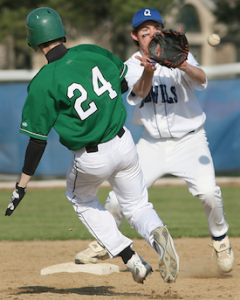 Most high school ballplayers have a passion for the game and a desire to constantly improve. They want to win a State championship. They want to earn a college scholarship. However, very few have the resources to put in the work that is needed to succeed. They want the end result, but do not have the right leaders to guide them through the process of achieving it. That’s too bad, because they are missing out on valuable lessons that are learned during that process – hard work, commitment, and time management are just a few that come to mind.
Most high school ballplayers have a passion for the game and a desire to constantly improve. They want to win a State championship. They want to earn a college scholarship. However, very few have the resources to put in the work that is needed to succeed. They want the end result, but do not have the right leaders to guide them through the process of achieving it. That’s too bad, because they are missing out on valuable lessons that are learned during that process – hard work, commitment, and time management are just a few that come to mind.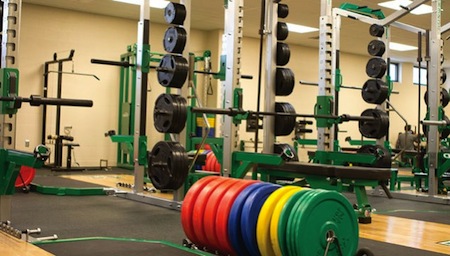

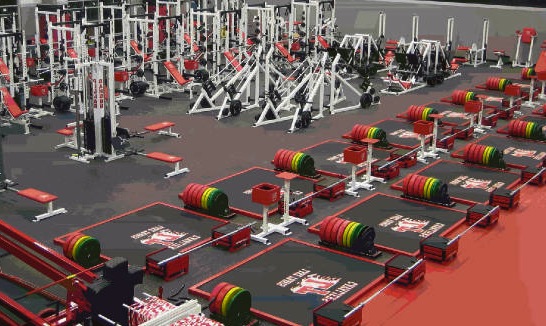
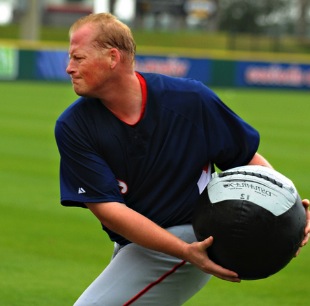




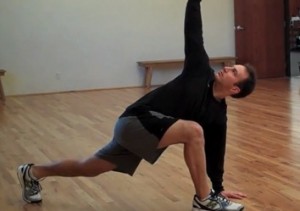 Dynamic Warm-up
Dynamic Warm-up